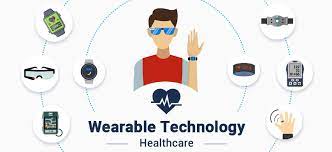Mark Zuckerberg says Meta wearables that read brain signals are coming soon
SOURCE: COINTELEGRAPH.COM
APR 19, 2024
How advancements in wearable tech could revolutionize industries
SOURCE: TECHSTRY.NET
MAR 22, 2022

Wearable technology is revolutionizing your everyday appearance and a wealth of industries. In this post, we’ll recap on what wearable technology really is (and what it is not!) before giving some common examples of these devices and examples of industries in pole position to benefit the most.
What is wearable tech?
Wearable technologies, sometimes shortened to ‘wearables’, are small devices with built-in microprocessors that can be worn on a person, added to clothing, attached to the skin, and get this – they can even be tattooed into the skin. Think back to your favorite Black Mirror episode.
In a nutshell, they are hands-free devices with practical uses that are carried on a person, often with the ability to send and receive information using the internet. Sometimes wearable technology that can access the internet is reclassified as smart wearables
The critical difference between wearable tech and something like a pair of spectacles – which might also be considered wearable tech – is that the technology in the latter does not encompass a microprocessor. Thus, wearable tech is a 21st Century invention only.
What are examples of wearable technology?
The most common and affordable examples of wearable technology are the different brands, devices, and watches used to track health and fitness. Lots of people are walking around with some sort of device on their person that is capable of tracking how many steps they have taken, how long they have remained sedentary, and even their sleep quality.
But some more high-end wearables at the time of writing include Augmented Reality (AR) headsets, Artificial Intelligence (AI) hearing aids, smart tattoos to monitor heart activity, smart jewelry, and even smart spectacles.
How wearable tech can transform industries?
As some of the examples above suggest, wearable technology has massive potential to penetrate an array of industries. In fact, there are probably fewer industries that it couldn’t benefit than those it could. Nevertheless, below you can find four industries and how wearable technology can enhance processes, products, and services in those niches.
1. Gaming industry
The gaming industry has already benefited from devices that can work to improve online gaming, such as headsets and microphones. But it is the gambling industry that may see some of the most notable benefits. Casinos and gaming sites can jump in on the action by upgrading their offering of mobile casino applications that are compatible with the latest wearable tech. For example, apps may become available on the newest smartwatch rather than just smartphones. And more ambitiously, wristbands with sensors could be used by players at home to instruct their games and even live dealers of their decisions.
2. Healthcare industry
The ability for doctors and nurses to receive data on patients in real-time can become exceptionally valuable and even life-saving. A number of wearable tech devices are already in use to send immediate data about a patient’s condition. Some examples include:
1. A smartwatch specifically designed for people with Parkinson’s. It transmits data to doctors who can use the data to create personalized care.
2. Wearable devices that notify elderly people about what medications need to be taken and when, so they don’t forget to take their meds.
3. A breast monitor that is capable of realizing early signs of potential breast cancer.
4. Wearable devices that detect poor air quality in residential areas, benefit people with respiratory illnesses.
5. Temporary tattoos fitted with electronic sensors that can monitor heart and brain activity among vulnerable populations.
3. Fitness industry
The fitness industry may be the most obvious industry to benefit the general public. The industry has already benefited from a wave of products capable of tracking performance in a wide range of sports, most of which are connected to the internet and apps to create a form of competition. More elite teams use the data to prevent injuries. The wearable tech can be used to realize when players are working at their maximum and when pushing further could cause harm – and times when pushing athletes is required. This has already been adopted in a wide variety of sports, especially team sports.
4. Insurance industry
As the healthcare industry adopts more wearable tech, the natural reaction is for health insurance companies to also get involved. There are some health insurance policy providers that now reward clients with cheaper insurance for living a healthier life, such as getting more sleep and exercising regularly. There are even examples of these insurers giving their clients free fitness trackers to prove their lifestyle and unlock better deals. Simultaneously, this prevents fraudulent health claims on insurance applications.
LATEST NEWS
Artificial Intelligence
Eerily realistic: Microsoft’s new AI model makes images talk, sing
APR 20, 2024
WHAT'S TRENDING


Data Science
5 Imaginative Data Science Projects That Can Make Your Portfolio Stand Out
OCT 05, 2022

SOURCE: COINTELEGRAPH.COM
APR 19, 2024
SOURCE: HTTPS://INTERESTINGENGINEERING.COM/
NOV 16, 2023
SOURCE: HTTPS://WWW.AZOSENSORS.COM/NEWS
AUG 28, 2023
SOURCE: WWW.WHATGADGET.NET
JUL 11, 2023
SOURCE: HTTPS://WWW.THEHINDU.COM/SCI-TECH/TECHNOLOGY/INDIAS-WEARABLE-MARKET-GREW-47-IN-2022-BOAT-MAINTAINS-LEAD-REPORT/ARTICLE66493121.ECE
JUN 30, 2023